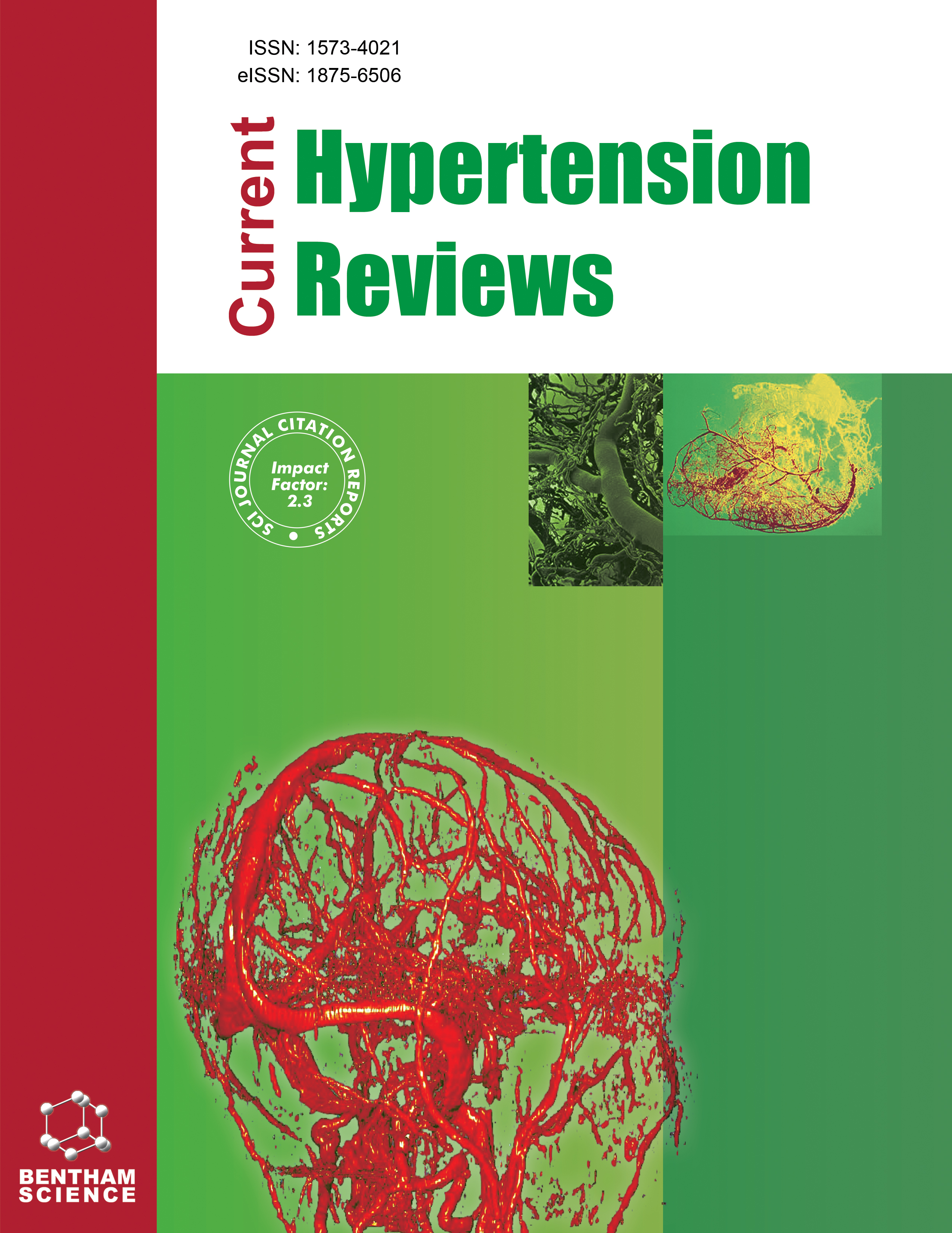- Home
- A-Z Publications
- Current Hypertension Reviews
- Previous Issues
- Volume 7, Issue 1, 2011
Current Hypertension Reviews - Volume 7, Issue 1, 2011
Volume 7, Issue 1, 2011
-
-
Masked Hypertension and Diabetes
More LessAuthors: Kazuo Eguchi and Kazuomi KarioIn patients with diabetes, control of blood pressure (BP) is as important as glycemic control in preventing cardiovascular disease. In hypertension and diabetes guidelines, the evaluation of BP is limited to clinic BP; out-of-office BP monitoring is not recommended for diabetic patients. Recently, an accumulation of evidence has shown that out-ofoffice BP monitoring is useful for risk stratification in diabetes. Especially, masked hy Read More
-
-
-
Nocturnal Hypertension and Chronic Kidney Disease
More LessAuthors: Michio Fukuda, Masashi Mizuno and Genjiro KimuraThe importance of the kidneys, as well as the renal function curve, in determining the arterial pressure (BP) has been widely-accepted (long-term BP regulation). Our recent studies have suggested that kidneys may participate in the pathogenesis of a circadian BP rhythm (short-term BP regulation). We have postulated that sodium sensitivity of BP is increased by both reduced glomerular ultrafiltration coefficient and by e Read More
-
-
-
Lifestyle Modification for Masked Hypertension
More LessBy Yuhei KawanoMasked hypertension is commonly seen in treated and untreated individuals and has been shown to be associated with target organ damage and poor cardiovascular prognosis. Although the etiology of masked hypertension appears to be complex, several lifestyle-related factors not only play important roles in the pathophysiology of essential hypertension but are also related to masked hypertension. Masked hypertension can Read More
-
-
-
Clinical Significance of the Blood Pressure Changes from Day to Night
More LessBlood pressure (BP) decreases by 10% to 20% from day to night. However, in 25% to 35% of hypertensive subjects there is some reduction in the day-night BP decline. In 3% to 5% of uncomplicated hypertensive subjects there is actually an increase, not a decrease, in BP from day to night. Many studies from independent centers showed that not only left ventricular hypertrophy, but also ventricular arrhythmias, silent cerebr Read More
-
-
-
Cardiac Remodeling and Exercise Training in Hypertension
More LessMyocardial hypertrophy secondary to hypertension is associated with a parallel addition of sarcomeres that characteristically increases cardiomyocyte cell size and width. From a cellular perspective, concentric hypertrophy differs from eccentric hypertrophy in that with eccentric hypertrophy, cardiomyocytes adapt by increasing sarcomeres in series thereby inducing an increase in cell length. Recently, specific sig Read More
-
-
-
Elevated Heart Rate, A Risk Factor and Risk Marker of Cardiovascular Disease
More LessAuthors: Taku Inoue and Yusuke OhyaEvidences from epidemiologic studies demonstrate that heart rate is an independent risk factor for cardiovascular disease events within a wide range of subjects. An increase in the resting heart rate predisposes to cardiometabolic abnormalities and is closely associated with them. Heart rate is also closely associated with inflammation, endothelial function, plaque formation and progression, eventually plaque rupture, and Read More
-
-
-
Hyperuricemia and Hypertension — A Causal Relationship Ignored For All Too Long
More LessBy Cornel PaterSoluble uric acid (UA) has traditionally been viewed by most scientific authorities as a biologically inert substance, possibly having anti-inflammatory properties as an antioxidant. Compelling evidence from a multitude of experimental and clinical studies carried out worldwide by different groups during the past two decades indicate that an elevated serum uric acid in humans is associated with hypertension, cardiovascular and kid Read More
-
-
-
Use of Diuretics in Women for Management of Hypertension
More LessAuthors: Eric J. MacLaughlin and Joseph J. SaseenCardiovascular disease remains the number one killer of women in the United States. Hypertension is considered a major cardiovascular risk factor, but remains poorly controlled in women. Thiazide diuretics are recommended as first line treatment in women with hypertension based on numerous outcomes studies demonstrating decreased risk of cardiovascular events. However, despite definitive evidence demonstratin Read More
-
Volumes & issues
-
Volume 21 (2025)
-
Volume 20 (2024)
-
Volume 19 (2023)
-
Volume 18 (2022)
-
Volume 17 (2021)
-
Volume 16 (2020)
-
Volume 15 (2019)
-
Volume 14 (2018)
-
Volume 13 (2017)
-
Volume 12 (2016)
-
Volume 11 (2015)
-
Volume 10 (2014)
-
Volume 9 (2013)
-
Volume 8 (2012)
-
Volume 7 (2011)
-
Volume 6 (2010)
-
Volume 5 (2009)
-
Volume 4 (2008)
-
Volume 3 (2007)
-
Volume 2 (2006)
-
Volume 1 (2005)
Most Read This Month
Article
content/journals/chyr
Journal
10
5
false
en


